Dewesoft X supports many different video cameras online. But there are cases (for example with very fast video cameras) where we have data file and the video file coming from the frame grabber. It is possible to synchronize those two files in Analysis mode with two simple steps:
- Include Video file to copy video file and re-name it according File name conventions
- Video synchronization to synchronize video file with analog data in the Dewesoft Xdata file with:
- synchronization settings
- resynchronize files
- storing post synchronization information
AVI and DVI format is required for synchronization!
File name conventions
To include the high-speed video in Dewesoft X, there are only a few steps necessary:
- After the acquisition of video file and the Dewesoft X measurement data, please copy *.avi high-speed camera file to the directory (via Windows Explorer) where the Dewesoft X data to be synchronized is located.
- Please rename the video file to this specification: xxxxx.cam0.avi, where 'xxxxx' is the name of the Dewesoft Xfile to be synchronized. If we have more video files, we can name then xxxx.cam0.avi, xxxx.cam1.avi, xxxx.cam2.avi, and so on.
 Image 31: Rename the video files to the xxx.cam0.avi format
Image 31: Rename the video files to the xxx.cam0.avi format
- Image 31 shows an example of how this looks like. Original Dewesoft X file is DF_AUTO_VTE_brake_test_thermo.dxd and therefore a video clip should be named DF_AUTO_VTE_brake_test_thermo.cam0.avi. After this open Dewesoft X, press the Analysis button to enter the Analyse mode and you should see already video file as part of the Dewesoft X data file.
Synchronization settings
After including video in the data file double click the file to open it. Dewesoft X will recognize that this file has no synchronization information included and will ask to synchronize it manually.
 Image 32: Video post synchronization
Image 32: Video post synchronization
The window displays the video file name and the number of stored frames (Frames found). Change the frame rate to the real capture rate of the camera (sometimes the .avi files hold correct values, but most of the time not). As an additional help, the Video size field shows you the video duration (length in seconds) at the currently selected frame rate.
After that, specify the Pre trigger - how many pictures have been taken before the video trigger occurred (choose between frames, seconds, and milliseconds).
Trigger time finally defines the start position of the video: from trigger means the first appearance of a trigger event (or start of measurement - storing of analog data). In this case, both the measurement systems and video cameras require the same trigger source.
The second way is to define video start from relative time. In this case, the mentioned time counts from the beginning of measurement in seconds.
After you have done all settings press OK button - the files will now be synchronized, but the synchronization information is not stored at this time! Dewesoft X will now display both files in the Video display.
Resynchronize files
The video display can be handled as any other instrument within Dewesoft X: zoom, scroll and scale, play, ... - whatever is required. If the synchronization is not perfect, it can still be adjusted by selecting the tab Data files -> Post-sync. video.
 Image 33: Post-sync video icon
Image 33: Post-sync video icon
NOTE: This option is only available if the synchronization information hasn't been stored.
Now you get the same Video post synchronization window as described in Synchronization settings. With an additional feature: Trigger time.
 Image 34: Post-sync from trigger
Image 34: Post-sync from trigger This is really a great feature, because you can zoom into your display, move the yellow cursor in the recorder to exactly defined position, and select Video post synchronization from the Data menu. If you do so, the video will be placed in the position of the yellow cursor. This will also work if a pretrigger is required.
Using this function, you can move position of the video file within the data file forward and backward as required.
Storing post synchronization information
Currently, there is no separate storage button available. To avoid doing all the synchronization setup every time, simply click on the Analysis button to go back to the file selection list. A warning message will now appear asking if the synchronization information should be stored now or not.
If you select Yes, the information is stored directly into the video file (not the data file) and is now available at any time, no further synchronization is required.
Warning: If you have stored post synchronization information once, it can't be changed anymore.
Therefore you should always keep a copy of the original video file, which doesn't contain this synchronization information.
Remove video from data files
To remove the assigned video from the data file, simply rename (or delete) the video file. In this case, the video file is not visible anymore in Dewesoft X. As the synchronization information is stored in the video file, there isn't even an error message, because the data file doesn't miss the video.
Make a short test: Rename the video back to the data file name and open it in Dewesoft X - the video is back and still synchronized.
 Image 1: Analysis mode
Image 1: Analysis mode 


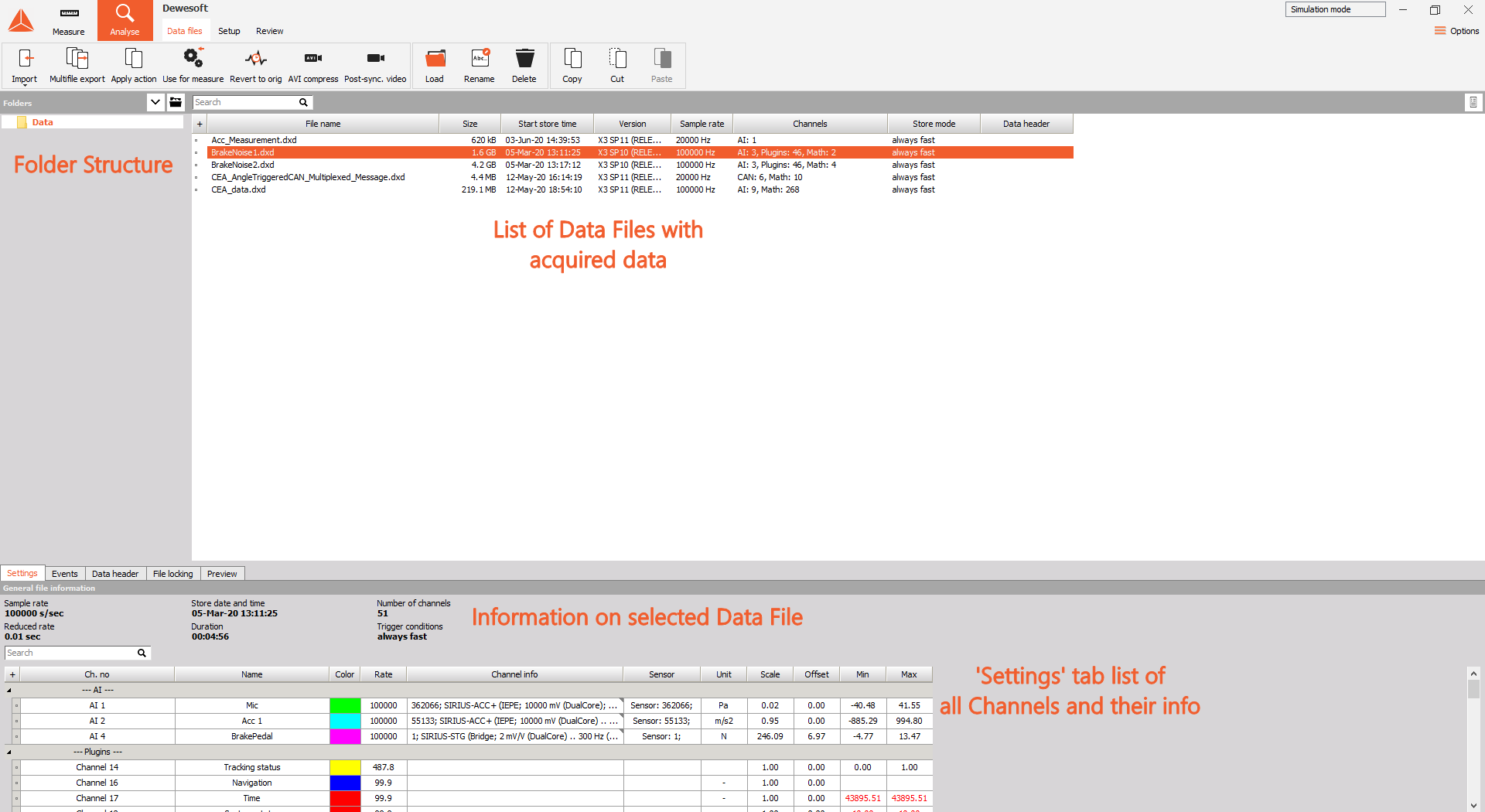











 to zoom in the whole area between the triggers. Use the left and right button
to zoom in the whole area between the triggers. Use the left and right button  to move between the triggered areas.
to move between the triggered areas.




 to fix cursor 1 to its current position. Lock cursor icon change to
to fix cursor 1 to its current position. Lock cursor icon change to  and the cursor will now change to green color and the number at its top changes to locked
and the cursor will now change to green color and the number at its top changes to locked  .
. icon again, so the cursor
icon again, so the cursor  disappears, and the cursor 1 is again available for new locks.The same can be done with 2nd cursor.
disappears, and the cursor 1 is again available for new locks.The same can be done with 2nd cursor.
 in the data preview. This gives us a chance to review the trigger events without zooming in the data. If we press it, the first trigger event is automatically zoomed in. The trigger mode button changes to the arrows button
in the data preview. This gives us a chance to review the trigger events without zooming in the data. If we press it, the first trigger event is automatically zoomed in. The trigger mode button changes to the arrows button  where we can browse between the events. If we press those two buttons, the recorder shows the trigger events one by one. On the data preview, we see the currently selected trigger event. On the first trigger, the only arrow
where we can browse between the events. If we press those two buttons, the recorder shows the trigger events one by one. On the data preview, we see the currently selected trigger event. On the first trigger, the only arrow  is available - to navigate forward to the second trigger and on last trigger, only arrow
is available - to navigate forward to the second trigger and on last trigger, only arrow  is available - to navigate backward.
is available - to navigate backward.



 .
. button. After pressing the Stop button don't forget to select None at the loudspeaker icon to switch off audio replay.
button. After pressing the Stop button don't forget to select None at the loudspeaker icon to switch off audio replay.



 to change the replay speed either on faster or slower.
to change the replay speed either on faster or slower.

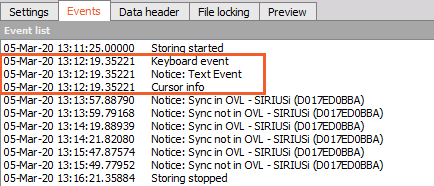
 icon to mark an area of interest. A thin gray vertical line will appear on the data at the location, marked with a symbol, and a notice is added to the scrolling EVENT box.
icon to mark an area of interest. A thin gray vertical line will appear on the data at the location, marked with a symbol, and a notice is added to the scrolling EVENT box.
 icon and then type some text in. The text input dialog box will appear:
icon and then type some text in. The text input dialog box will appear:

 and then speak into the microphone. Release the key when done. These voice events can be replayed through your speakers later on, and are a great way to add a rich layer of information to your data. This event is marked with the icon 'V' and a thin vertical blue line.
and then speak into the microphone. Release the key when done. These voice events can be replayed through your speakers later on, and are a great way to add a rich layer of information to your data. This event is marked with the icon 'V' and a thin vertical blue line.






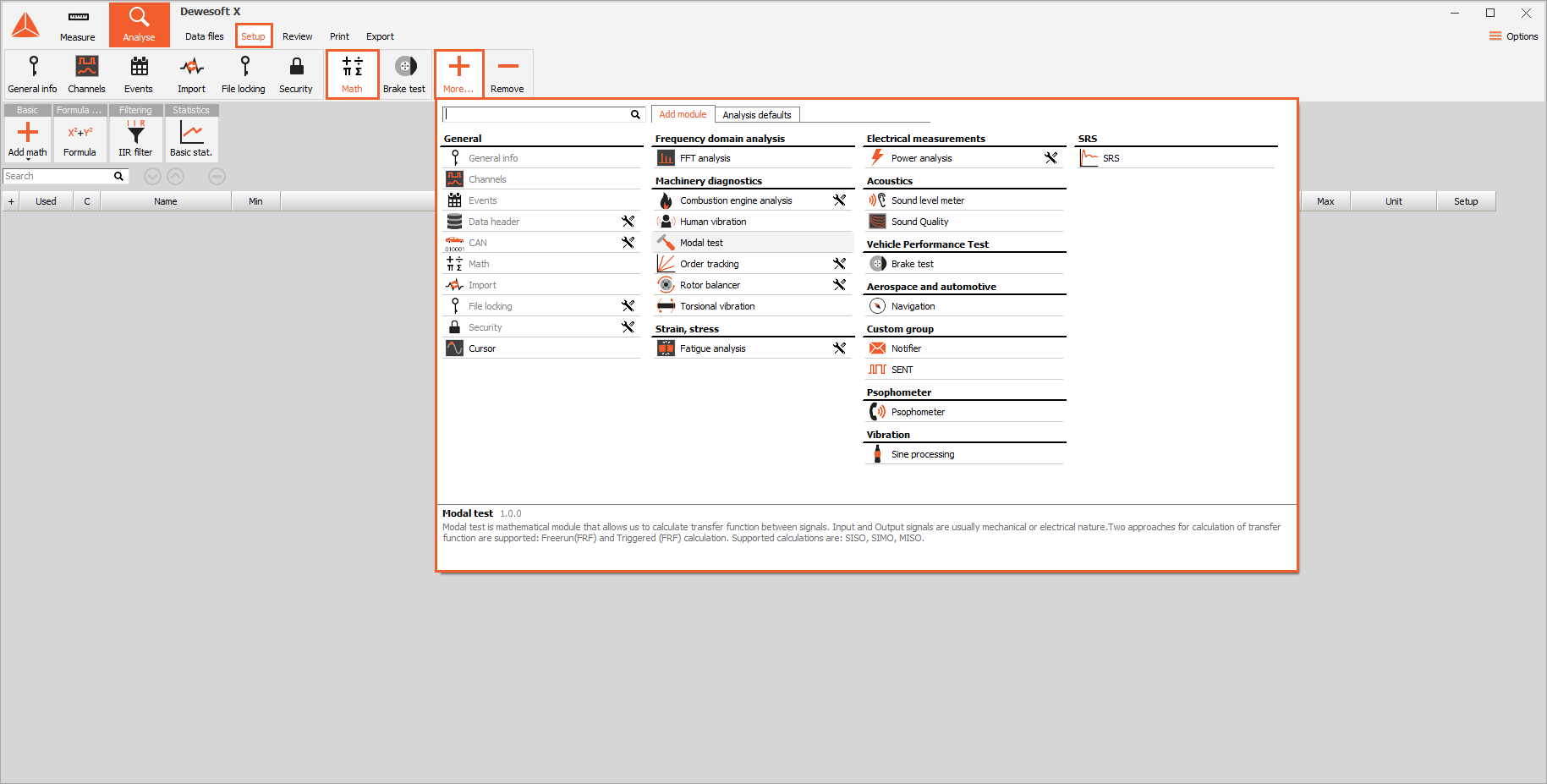



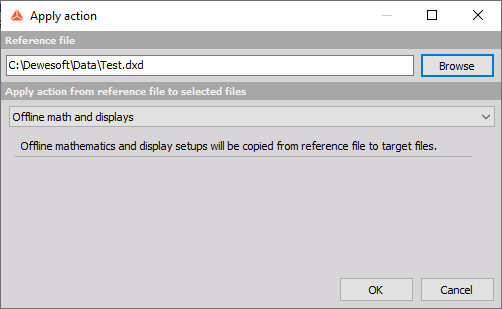

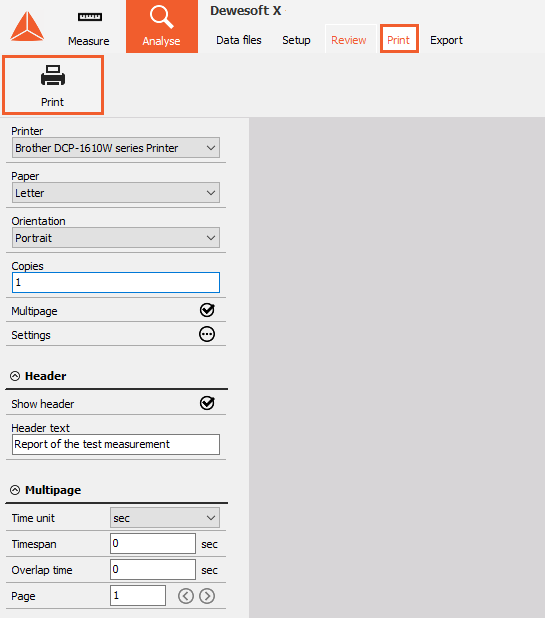



 for navigation
for navigation  for navigation
for navigation 
